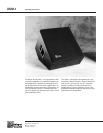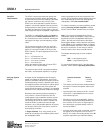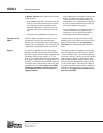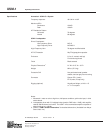
Operating Instructions
Meyer Sound Laboratories, Inc.
2832 San Pablo Avenue
Berkeley, CA 94702
USM-1
The USM-1 requires a professional quality two-
channel power amplifier rated at 300 watts per
channel minimum (and not exceeding 1000 watts
per channel) continuous into 8 ohms. (If two
USM-1’s are to be operated in parallel from the
amplifier, it should be capable of driving 4 ohms.)
Using amplifiers of lower power will not allow the
full power and headroom of the USM-1 to be real-
ized, though this may be acceptable in applications
where high pressure levels are not required. Con-
versely, use of amplifiers rated at significantly more
than 1000 watts per channel may endanger the
loudspeaker, and is not recommended.
For further information on power amplifiers, please
refer to Choosing a Power Amplifier, a Meyer
Sound Technical Note available from your dealer.
Connections
The USM-1 is a biamplified system and must be
used with the S-1 Control Electronics Unit. The
S-1 functions as an active crossover, dividing the
input signal into high- and low-frequency compo-
nents.
The connection terminals of the low- and high-
frequency drivers appear on a single Cannon P-
type 4-pin connector located on the rear of the
USM-1 cabinet. The pin assignments for this con-
nector are:
Pin 1 — 15-inch driver, hot
Pin 2 — 15-inch driver, common
Pin 3 — horn driver, common
Pin 4 — horn driver, hot
(When the cabinet is fitted with a Cannon EP-5
connector, Pin 5 is unconnected)
The minimum wire size for connections between
the USM-1 and the power amplifier is 14 gauge.
Note. If you are using standard Meyer Sound
loudspeaker cables and adapters, simply connect
the female end of the loudspeaker cable to the
USM-1, the male end of the cable to the Meyer
Sound pigtail adapter, and the banana connectors
of the adapter to your amplifier outputs. In making
connections between the USM-1 and the amplifier,
be sure to connect the 15-inch driver to the Lo
channel, and the horn driver to the Hi channel.
The adapter banana plugs are color-coded as
follows:
Red — Low frequency driver
Black — High frequency driver
For connections between the S-1 and the power
amplifier, refer to the S-1 Operating Instructions.
Verifying System
Polarity
All Meyer Sound loudspeakers are thoroughly
tested in all stages of manufacture, and correct
polarity of individual cabinets is assured. However,
accidental polarity reversal is possible when there
are multiple amplifier connections. A cabinet which
is out of polarity with the rest of the system will
cause severe cancellation, resulting in a noticeable
decrease in SPL and possible component damage.
Because of the extensive signal processing cir-
cuitry of the S-1 Control Electronics Unit, the
“phase-popper” type of speaker checkers cannot
reliably be used to test for correct polarity of the
low and high drivers of the USM-1. However, be-
cause the USM-1 is phase corrected through
crossover, any of the portable spectrum analyzers
can be used, with a pink noise source, to test for
driver polarity as follows:
1. Single Cabinets. First, verify polarity of the
woofer by connecting a 9-volt battery at the end of
the loudspeaker cable.
Amplifier
Requirements
Cannon connector Battery
Pin 1 + terminal
Pin 2 - terminal
• The woofer cone should move outward toward
the listener. Connect the speaker cable to the
amplifier.
• Input the pink noise source to the S-1 and ad-
vance the S-1 input Level control to a conve-
nient measuring level.
• Standing in front of the loudspeaker, position
the analyzer microphone directly between the
horn and the 15-inch driver, at right angles to
the cabinet face, and about twenty inches in
front of the USM-1.
• If polarity of the horn driver is reversed, a trough
will appear in the response curve at around
900 Hz. If in doubt, reverse the polarity of the Hi
amplifier output while you watch the display.






